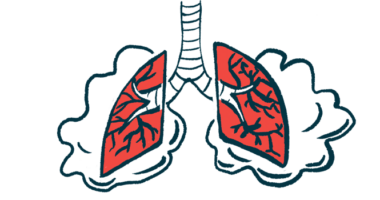A. fumigatus Lung Infections Linked to Age, Long-term Antibiotic Use

Adult age up to 50 and chronic antibiotic use seem to be the greatest risk factors for lung infection by the fungus Aspergillus fumigatus among cystic fibrosis (CF) patients, according to a study in Germany.
The study, “Risk factors for respiratory Aspergillus fumigatus in German Cystic Fibrosis patients and impact on lung function,” was published in Nature Scientific Reports.
Bacteria, such as Pseudomonas aeruginosa, most often colonize the lungs of CF patients. The resulting inflammation and chronic lung infections are the leading cause of morbidity and mortality in this patient population.
“Despite treatment options of initial PA [P. aeruginosa] infection, permanent elimination is not always possible, and chronic infection is common in older patients (53.1% in adult patients vs. 9.8% in patients younger than 18 years), with accordingly long-term antibiotic use,” the researchers wrote.
Increasing evidence also points toward a harmful role played by fungi, but this is less well understood.
Among fungal infections in CF, A. fumigatus is one of the most common. This fungus is known to cause allergic bronchopulmonary aspergillosis (ABPA) and acute lung infections that affect quality of life. Co-infection of A. fumigatus with P. aeruginosa is also associated with more hospitalization and poorer lung function.
Age and continuous antibiotic use have been discussed as risk factors for A. fumigatus colonization, but more study is needed.
To address A. fumigatus infection and lung disease in CF patients, researchers at several German institutions analyzed data from the German CF Registry collected between 2016 and 2017 — covering a total of 5,665 patients — looking for correlations between lung function, chronic infection, and CF treatments.
Patients with transient A. fumigatus colonization as well as persistent colonization were analyzed.
The team found records of fungi in CF patients of all ages, with the infection rate of A. fumigatus rising until about age 49, after which it declined.
Candida albicans and related species were the most common fungal species in patients’ lungs: 42.8% in 2016 and 42.0% in 2017 for C. albicans, and 24.8% and 25.6%, respectively, for other Candida species.
A. fumigatus and related species were the next most common species: 27.3% in 2016 and 25.5% in 2017 for A. fumigatus, and 4.8% and 4.6% for the other related species.
Of CF patients with at least two visits and microbiological tests done per year (3,698 in 2016, and 4,153 in 2017), 15.4% in 2016 and 13.9% in 2017 had at least two A. fumigatus-positive cultures.
Compared to patients without A. fumigatus-positive cultures, those with at least two had significantly lower body mass indices and significantly more ABPA, CF-related diabetes, and arthritis or other joint disorders.
In keeping with past studies, patients with chronic P. aeruginosa infection had significantly poorer lung function, as measured by forced expiratory volume in one second (FEV1), than those without. Patients without chronic P. aeruginosa infection but with at least one positive A. fumigatus infection also had significantly lower FEV1, implying that A. fumigatus may directly impair lung function.
Those with at least two A. fumigatus-positive cultures also experienced significantly more pulmonary exacerbations requiring antibiotic treatment.
Treatment overall differed in patients with and without fungal infection, mainly by antibiotic and bronchodilator use. Continuous antibiotic use was significantly associated with the presence of A. fumigatus, and significantly more patients with at least two A. fumigatus-positive cultures used bronchodilators with steroid treatment (often prescribed together).
About 10% of patients without A. fumigatus diagnosis received antifungal treatment, although slightly more individuals with one or more A. fumigatus-positive cultures were given such treatment.
Among patients using a CFTR modulator therapy, the only considerable difference was that significantly more patients with two or more positive fungal cultures received lumacaftor.
Bacterial infection by P. aeruginosa occurred alongside A. fumigatus in significantly more patients with at least two positive A. fumigatus cultures, than was found in patients with one or fewer cultures. Co-infection with Staphylococcus aureus, another common bacterial infection, differed little across patients.
Overall, age and chronic antibiotic use were found to be independent risk factors for persistent A. fumigatus infection. Risk increased with age up to about 49 years old, after which it began to decline.
These results “show a decrease in [A. fumigatus] prevalence in CF patients older than 50 years. This might reflect that getting older with CF presupposes a milder CF disease or a better lung health status, which prevents from [A. fumigatus] colonisation. Nevertheless, older age was found to be the strongest risk factor for persistent [A. fumigatus] colonisation,” the researchers wrote.
“Further studies,” they added, “are needed to elucidate the clinical impact of A. fumigatus for CF patients and to define patients who would benefit from an antifungal treatment to prevent lung function decline or lung damage.”







